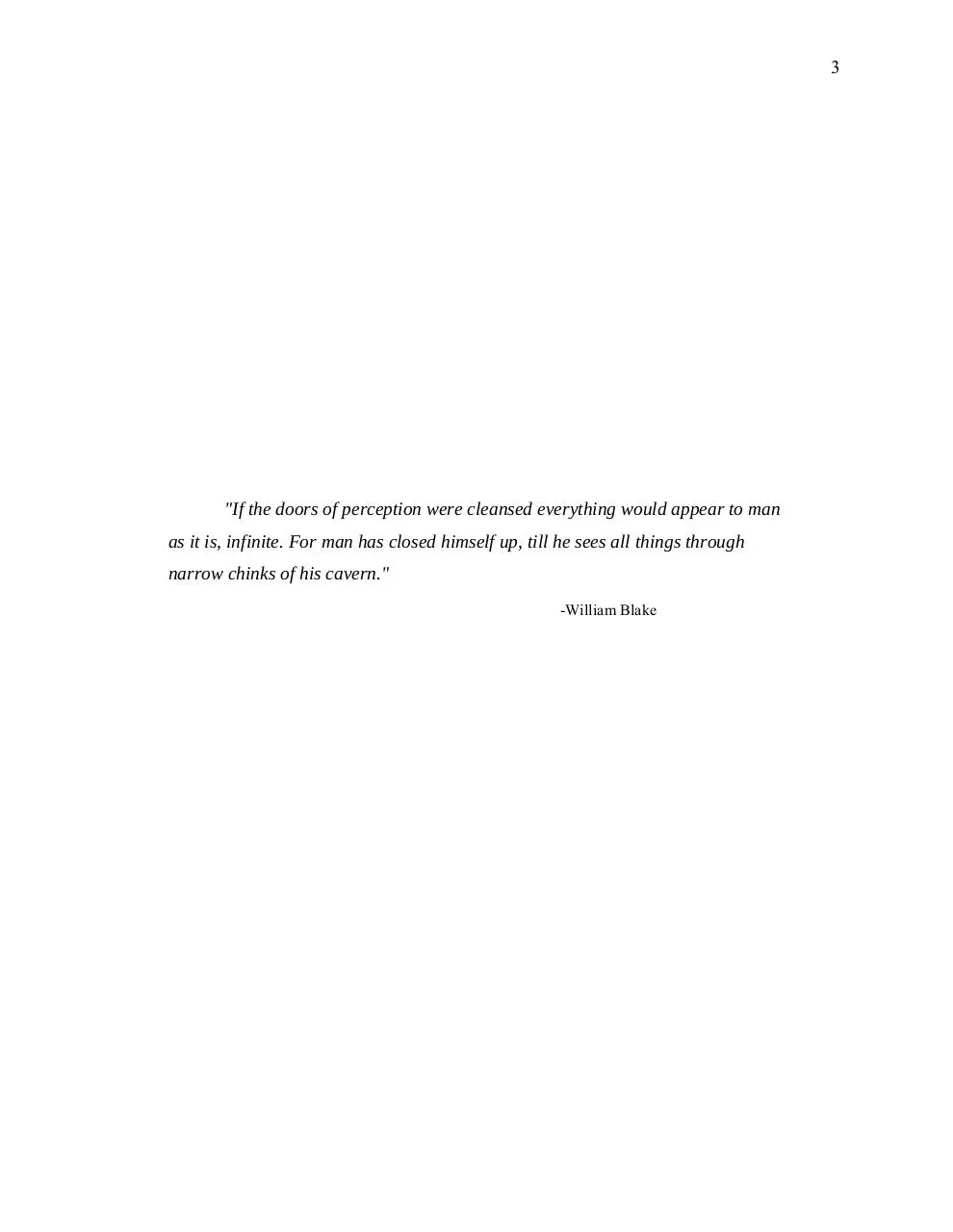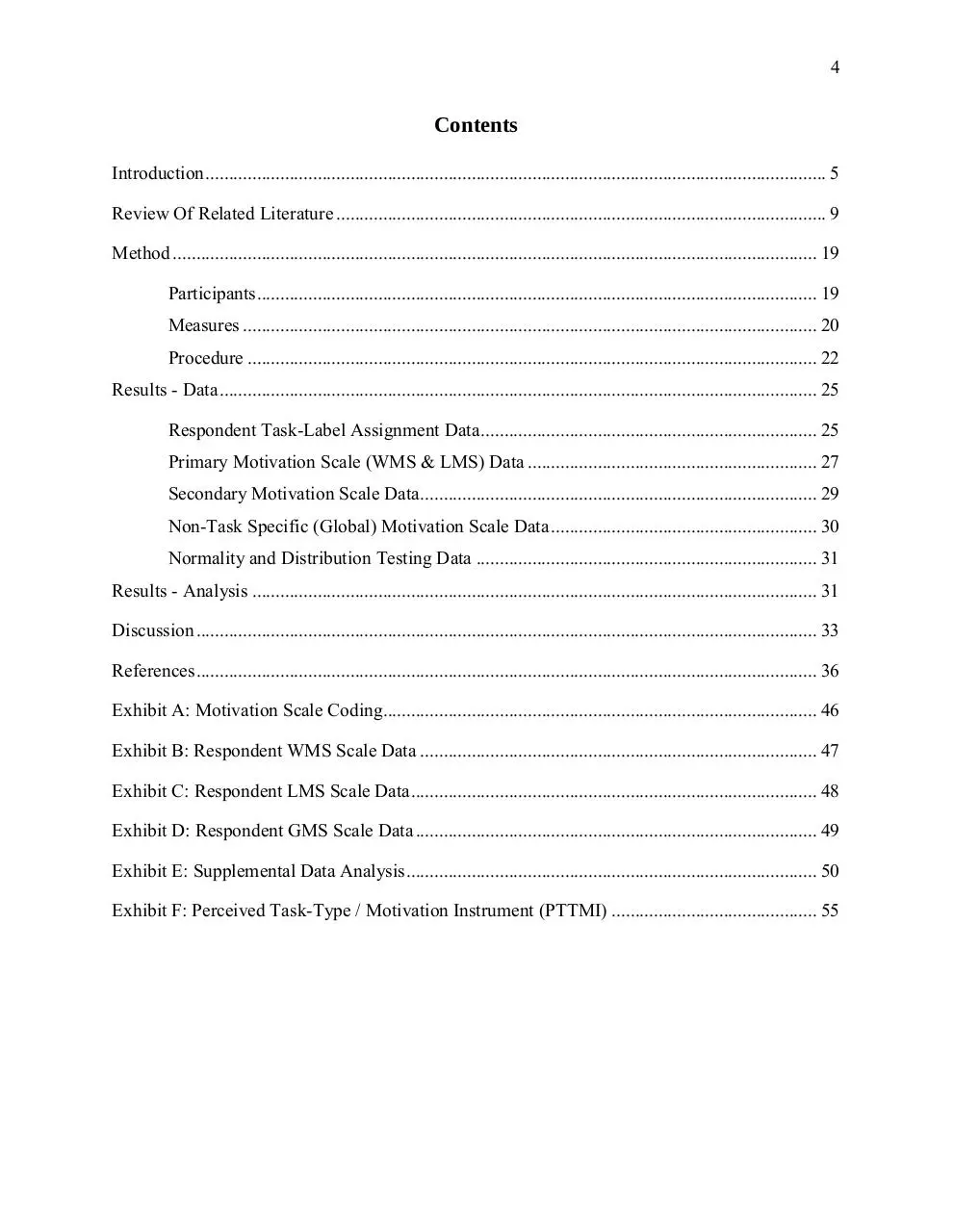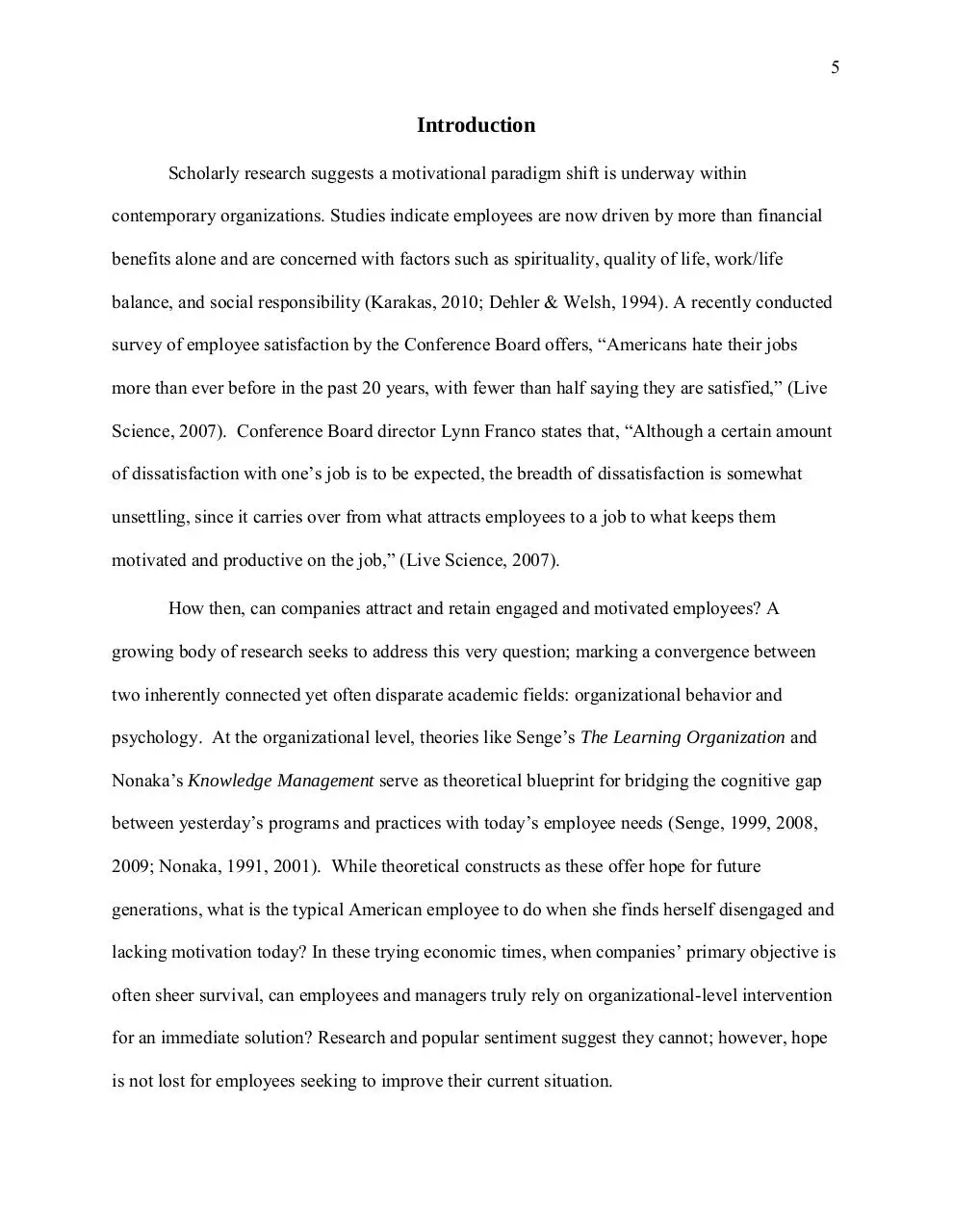WDuffey Subjective Task Perception & Motivational Outcomes (PDF)
File information
Author: WNDIII
This PDF 1.5 document has been generated by Microsoft® Word 2010, and has been sent on pdf-archive.com on 28/04/2015 at 04:00, from IP address 50.177.x.x.
The current document download page has been viewed 626 times.
File size: 1.05 MB (74 pages).
Privacy: public file





File preview
Subjective Task Perception and Motivational Outcomes:
Toward Lifting the Veil on Work-Leisure Constructs
2
Abstract
Past studies have examined how social cues (someone else introducing a task as work or
leisure) affect motivation; however few empirical inquiries have determined whether or not one’s
own task-type perception shares a similar moderating effect. This study examines how subjective
perception of a task as work or leisure influences motivation. Twenty-nine American working
and retired professionals completed the Perceived Task-Type / Motivation Instrument (PTTMI).
Results revealed people are more motivated, on average, during tasks perceived as leisure than
tasks perceived as work. As such, the study’s implications are dually served both for practical
lines of perceptive intervention, and as call-to-action for further theoretical examination.
3
"If the doors of perception were cleansed everything would appear to man
as it is, infinite. For man has closed himself up, till he sees all things through
narrow chinks of his cavern."
-William Blake
4
Contents
Introduction ..................................................................................................................................... 5
Review Of Related Literature ......................................................................................................... 9
Method .......................................................................................................................................... 19
Participants ........................................................................................................................ 19
Measures ........................................................................................................................... 20
Procedure .......................................................................................................................... 22
Results - Data ................................................................................................................................ 25
Respondent Task-Label Assignment Data ........................................................................ 25
Primary Motivation Scale (WMS & LMS) Data .............................................................. 27
Secondary Motivation Scale Data ..................................................................................... 29
Non-Task Specific (Global) Motivation Scale Data ......................................................... 30
Normality and Distribution Testing Data ......................................................................... 31
Results - Analysis ......................................................................................................................... 31
Discussion ..................................................................................................................................... 33
References ..................................................................................................................................... 36
Exhibit A: Motivation Scale Coding............................................................................................. 46
Exhibit B: Respondent WMS Scale Data ..................................................................................... 47
Exhibit C: Respondent LMS Scale Data ....................................................................................... 48
Exhibit D: Respondent GMS Scale Data ...................................................................................... 49
Exhibit E: Supplemental Data Analysis ........................................................................................ 50
Exhibit F: Perceived Task-Type / Motivation Instrument (PTTMI) ............................................ 55
5
Introduction
Scholarly research suggests a motivational paradigm shift is underway within
contemporary organizations. Studies indicate employees are now driven by more than financial
benefits alone and are concerned with factors such as spirituality, quality of life, work/life
balance, and social responsibility (Karakas, 2010; Dehler & Welsh, 1994). A recently conducted
survey of employee satisfaction by the Conference Board offers, “Americans hate their jobs
more than ever before in the past 20 years, with fewer than half saying they are satisfied,” (Live
Science, 2007). Conference Board director Lynn Franco states that, “Although a certain amount
of dissatisfaction with one’s job is to be expected, the breadth of dissatisfaction is somewhat
unsettling, since it carries over from what attracts employees to a job to what keeps them
motivated and productive on the job,” (Live Science, 2007).
How then, can companies attract and retain engaged and motivated employees? A
growing body of research seeks to address this very question; marking a convergence between
two inherently connected yet often disparate academic fields: organizational behavior and
psychology. At the organizational level, theories like Senge’s The Learning Organization and
Nonaka’s Knowledge Management serve as theoretical blueprint for bridging the cognitive gap
between yesterday’s programs and practices with today’s employee needs (Senge, 1999, 2008,
2009; Nonaka, 1991, 2001). While theoretical constructs as these offer hope for future
generations, what is the typical American employee to do when she finds herself disengaged and
lacking motivation today? In these trying economic times, when companies’ primary objective is
often sheer survival, can employees and managers truly rely on organizational-level intervention
for an immediate solution? Research and popular sentiment suggest they cannot; however, hope
is not lost for employees seeking to improve their current situation.
6
Psychologist Mihaly Csikszentmihalyi has dedicated over three decades of research
addressing the question of how employees, and people in general, can improve work and
everyday experiences. In his theory of flow, Csikszentmihalyi’s baseline inquiry extends well
beyond the walls of the organization, and seeks to answer, in general, “what makes a life worth
living,” (www.ted.com, 2008). In his examination of artists, athletes, and heads of corporate
industry, Csikszentmihalyi’s focus lies on the near ecstatic, out-of-body, human state - that can
be generated when a person reaches a harmonious balance between challenges and skills. He
argues that this state of flow resides somewhere between high degrees of arousal and control, and
seeks to qualify the conditions necessary to reach this point (www.ted.com, 2008). His principle
thesis is that “the consequence of forging life by purpose and resolution is a sense of inner
harmony, a dynamic order in the contents of consciousness,” (Csikszentmihalyi, 1990).
The concept holds relevance for the organizational environment due to the theory’s
implications for employee motivation; in flow, people function at their fullest capacity, and the
activity itself is the reward. When experiences are reclaimed and liberated through
consciousness, “one begins to harvest the genuine rewards of living,” rather than “forever
straining for the tantalizing prize dangled just out of reach,” (Csikszentmihalyi, 1990). This can
also be qualified as intrinsic motivation: “motivation to engage in an activity purely for the sake
of the activity itself,” (Lepper, Greene, & Nisbett, 1973). Intrinsic motivation is more sustainable
and cost effective than extrinsic motivation, since the necessity of complex and costly reward
systems are eliminated or reduced from the equation. In addition, because individuals seek to
replicate flow experiences; “this introduces a selective mechanism into psychological
functioning that fosters growth,” (Shernoff, Csikszentmihalyi, Schneider, & Shernoff, 2003).
7
In their seminal 1989 article, Optimal Experience in Work and Leisure, LeFevre’s and
Csikszentmihalyi’s findings offered compelling insight into the relationship between employee
perceptions and quality of experience. The researchers offer, “Commonsense assumptions
notwithstanding, the most positive experiences in people’s lives seem to come more frequently
from work than from leisure settings,” (Csikszentmihalyi & LeFevre, 1989, p. 820). These
findings lead to a noted paradoxical situation because most people identify leisure time as more
positive. Csikszentmihalyi and LeFevre offer that the “obligatory nature of work masks the
positive experience it engenders,” resulting in a discrepancy between cognition and reality
(Csikszentmihalyi & LeFevre, 1989, p. 821).
In an effort to thwart societal disconnect between cognition and reality, Csikszentmihalyi
and LeFevre propose two “lines of intervention that suggest themselves for improving these
conditions,” (Csikszentmihalyi & LeFevre, 1989, p. 821). The first solution is for people to
acknowledge, “How many negative feelings they experience when their free time does not meet
the conditions of flow,” and second to “disregard the cultural mandate against enjoying work,”
(Csikszentmihalyi & LeFevre, 1989, p. 821). Though in the twenty-two years since the study,
Csikszentmihalyi and others have examined the role of flow, intrinsic motivation, and quality of
experience, there exists a void in the research addressing employees’ perceptions as an
intervening or moderating variable.
The goal of this study is to address this void, by examining the degree to which
employees’ perception of a task or activity as “work” or as “leisure” impact motivation levels. Of
specific interest is how employee work/leisure task perception affects whether or not they find
the experience intrinsically rewarding. While this inquest undoubtedly addresses a noted void
within the study of Flow Theory and Intrinsic Motivation, of arguably greater value are the
8
practical implications on both the individual and organizational level. In exploring the role of
employee perception on motivation, findings from this and subsequent studies would provide
invaluable insight for organizations and managers for facilitating employee motivation (and
more notably for facilitating intrinsic motivation). Such findings would benefit various
disciplines such as leadership and management studies, strategic human resource management,
as well as work/life balance and spirituality in the workplace research.
Beyond the practical implications for elevating organizational performance, there are also
profound potential gains for individual employees. A goal of this study is to begin a dialogue on
how companies can assist in improving the daily experiences of their employees. By
empowering employees with self-awareness and helping them release from the shackles of their
own mental models – the burdensome and onerous construct that is “work” could be slowly
redefined. Rather than viewing nine-to-five or Monday-to-Friday as obligatory, loathed gaps
between enjoyment and happiness, daily work activities could be viewed as enriching exercises
marked by personal growth.
With the end-goal of substantive insight for training and development interventions, the
present study will address the following hypotheses:
H0
Perception of a task as work or as leisure will not affect respondent motivation.
H1
Perception of a task as work or as leisure will effect motivation during the task.
H2
Results will indicate higher mean motivation levels during perceived leisure
activities than perceived work activities.
9
Review of Related Literature
As the catalyst for the present study, an appropriate starting point is an exploration of
Csikszentmihalyi’s and LeFevre’s Optimal Experience in Work and Leisure. Addressing one of
the primary research questions, they found that “contrary to expectations, these flowlike
situations occurred more than three times as often in work as in leisure,” (Csikszentmihalyi &
LeFevre, 1989, p. 818). While the article does not offer a substantial overview of all hypotheses
maintained by the researchers, the introduction does reference the misconception that leisure is
more conducive to flow. The fact that the evidence suggests otherwise is important because it has
shaped much of the subsequent research on the topic. In addition, these results shaped the line of
inquiry for nearly all of Csikszentmihalyi’s subsequent research (Abuhamdeh &
Csikszentmihalyi, 2009), and the focus of this investigation.
Researchers continue to debate over the degree to which employee perceptions influence
performance and behavior. The theory of planned behavior is offered as one construct to
reconcile this, and proposes, “intention to perform a behavior is influenced by the person’s
attitude toward the behavior, his or her subjective norm, and his or her perceived control over
perceived difficulty of performing the behavior,” (Song, Wanberg, Niu, & Xie, 2006, p. 491). In
their 2006 examination of employee culture-based perceptions as motivational predictors, Emery
and Oertel offer that two of the most widely recognized motivational theories: McClelland’s
(1962) Learned Needs Theory and Vroom’s (1964) Expectancy Theory, “suggest performance
motives reflect persistent characteristics or perceptions of reality,” (Emery & Oertel, 2006). In
addition, they continue that both Hofstede’s and Maslow’s theories are also predicated on the
fact that employees’ perceptions influence motivation (Emery & Oertel, 2006).
Download WDuffey - Subjective Task Perception & Motivational Outcomes
WDuffey - Subjective Task Perception & Motivational Outcomes.pdf (PDF, 1.05 MB)
Download PDF
Share this file on social networks
Link to this page
Permanent link
Use the permanent link to the download page to share your document on Facebook, Twitter, LinkedIn, or directly with a contact by e-Mail, Messenger, Whatsapp, Line..
Short link
Use the short link to share your document on Twitter or by text message (SMS)
HTML Code
Copy the following HTML code to share your document on a Website or Blog
QR Code to this page

This file has been shared publicly by a user of PDF Archive.
Document ID: 0000223164.